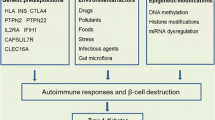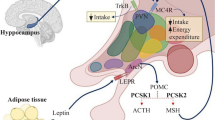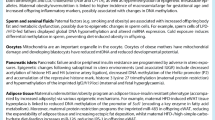Abstract
Leptin is an adipokine involved in body weight and food intake regulation whose promoter region presents CpG islands that could be subject to dynamic methylation. This methylation process could be affected by environmental (e.g. diet) or endogenous (e.g., adipocyte differentiation, inflammation, hypoxia) factors, and could influence adipocyte leptin gene expression. The aim of this article was to study whether a high-energy diet may affect leptin gene promoter methylation in rats. A group of eleven male Wistar rats were assigned into two dietary groups, one fed on a control diet for 11 weeks and the other on a high-fat cafeteria diet. Rats fed a high-energy diet become overweight and hyperleptin emic as compared to the controls. DNA isolated from retroperitoneal adipocytes was treated with bisulfite and a distal portion of leptin promoter (from −694 to −372 bp) including 13 CpG sites was amplified by PCR and sequenced. The studied promoter portion was slightly more methylated in the cafeteria-fed animals, which was statistically significant (p<0.05) for one of the CpG sites (located at the position −443). In obese rats, such methy lation was associated to lower circulating leptin levels, suggesting that this position could be important in the regulation of leptin gene expression, probably by being a target sequence of different transcription factors. Our findings reveal, for the first time, that leptin methylation pattern can be influenced by diet-induced obesity, and suggest that epigenetic mechanisms could be involved in obesity by regulating the expression of important epiobesigenic genes.
Resumen
La leptina es una adipoquina implicada en la regulación del peso corporal y la ingesta energética cuya región promotora presenta islas CpG que podrían ser metiladas dinámicamente. Este proceso de metilación podría verse afectado por factores ambientales, como la dieta, o endógenos, como la diferenciación adipocitaria, inflamación o hipoxia, y podría influir en la expresión de leptina por parte de los adipocitos. El objetivo de este artículo es estudiar si una dieta alta en grasa podría afectar a la metilación del promotor de la leptina en ratas. Un grupo de once ratas Wistar macho fue dividido en dos subgrupos, uno alimentado con dieta control durante 11 semanas y el otro con dieta alta en grasa (dieta de cafetería). Las ratas alimentadas con la dieta rica en grasa presentaron sobrepeso e hiperleptinemia. El ADN aislado de los adipocitos retroperitoneales fue tratado con bisulfito y una porción distal del promotor de la leptina (de la base-694 a la — 372), conteniendo 13 sitios CpG, fue amplificada por PCR y secuenciada. Esta región del promotor apareció ligeramente más metilada en los animales alimentados con dieta de cafetería, lo cuál fue especialmente significativo (p <0,05) para uno de los sitios CpG (en la posición-443). En las ratas obesas, la metilación se asoció a una disminución de los niveles de leptina circulante, lo que sugiere que esta posición podría ser importante en la regulación de la expresión génica de esta adipoquina, probablemente por ser una secuencia diana de diferentes factores de trnascripción. Nuestos resultados, por primera vez, ponen de manifiesto que el patrón de metilación del promotor de la leptina puede estar influido por la obesidad inducida por la dieta, y sugieren que los mecanismos epigenéticos podrían estar implicados en la reciente pandemia de obesidad mediante la regulación de la expresión de importantes genes epiobesigénicos.
Similar content being viewed by others
References
Beischlag, T.V., Luis Morales, J., Hollingshead, B.D. and Perdew, G.H. (2008): The aryl hydrocarbon receptor complex and the control of gene expression.Crit Rev Eukaryot Gene Expr,18, 207–250.
Campion, J., Milagro, F.I., Fernández, D. and Martínez, J.A. (2006): Diferential gene expression and adiposity reduction induced by ascorbic acid supplementation in a cafeterial model of obesity.J Physiol Biochem,62, 71–80.
Edwards, T. M. and Myers, J. P. (2007): Environmental exposures and gene regulation in disease etiology.Environ Health Perspect,115, 1264–1270.
Finnegan, E.J. (2001): Is plant gene expression regulated globally?Trends Genet,17, 361–365.
Franco, R., Schoneveld, O., Georgakilas, A.G. and Panayiotidis, M.I. (2008): Oxidative stress, DNA methylation and carcinogenesis.Cancer Lett,266, 6–11.
Gallou-Kabani, C., Vige, A., Gross, M.S. and Junien, C. (2007): Nutri-epigenomics: lifelong remodelling of our epigenomes by nutritional and metabolic factors and beyond.Clin Chem Lab Med,45, 321–327.
García-Díaz, D.F., Campion, J., Milagro, F.I., Lomba, A., Marzo, F. and Martínez, J.A. (2007): Chronic mild stress induces variations in locomotive behavior and metabolic rates in high fat fed rats.J Physiol Biochem,63, 337–346.
Grosfeld, A., Andre, J., Hauguel-De Mouzon, S., Berra, E., Pouyssegur, J. and Guerre-Millo, M. (2002): Hypoxia-inducible factor 1 transactivates the human leptin gene promoter.J Biol Chem,277, 42953–42957.
Hernández-Morante, J.J., Milagro, F.I., Lujan, J.A., Martínez, J.A., Zamora, S. and Garaulet, M. (2008): Insulin effect on adipose tissue (AT) adiponectin expression is regulated by the insulin resistance status of the patients.Clin Endocrinol (Oxf),69, 412–417.
Iguchi-Argia, S.M. and Schaffner, W. (1989): CpG methylation of the cAMP-responsive enhancer/promoter sequence TGACGTCA abolishes specific factor binding as well as transcriptional activation.Genes Dev,3, 612–619.
Johnson, I.T. and Belshaw, N.J. (2008): Environment, diet and CpG island methylation: epigenetic signals in gastrointestinal neoplasia.Food Chem Toxicol,46, 1346–1359.
Junien, C. (2006): Impact of diets and nutrients/drugs on early epigenetic programming.J Inherit Metab Dis,29, 359–365.
Junien, C and Nathanielsz, P. (2007): Report on the IASO Stock Conference 2006: early and lifelong environmental epigenomic programming of metabolic syndrome, obesity and type II diabetes.Obes Rev,8, 487–502.
Kotsopoulos, J., Sohn, K.J. and Kim, Y.I. (2008): Postweaning dietary folate deficiency provided through childhood to puberty permanently increases genomic DNA methylation in adult rat liver.J Nutr,138, 703–709.
Kumaki, Y., Oda, M. and Okano, M. (2008): QUMA: quantification tool for methylation analysis.Nucleic Acids Res,36, W170–175.
Li, L.C. and Dahiya, R. (2002): Meth Primer: designing primers for methylation PCRs.Bioinformatics,18, 1427–1431.
Liu, L., Li, Y. and Tollefsbol, T.O. (2008): Geneenvironment interactions and epigenetic basis of human diseases.Curr Issues Mol Biol,10, 25–36.
Marti, A., Berraondo, B. and Martínez, J.A. (1999): Leptin: physiological actions.J Physiol Biochem,55, 43–49.
Melzner, I., Scott, V., Dorsch, K., Fischer, P., Wabitsch, M., Bruderlein, S., Hasel, C. and Moller, P. (2002): Leptin gene expression in human preadipocytes is switched on by maturation-induced demethylation of distinet CpGs in its proximal promoter.J Biol Chem,277, 45420–45427.
Milagro, F.I., Campion, J. and Martínez, J.A. (2007): 1-Beta hydroxysteroid dehydrogenase type 2 expression in white adipose tissue is strongly correlated with adiposity.J Steroid Biochem Mol Biol,104, 81–84.
Rocha, S. (2007): Gene regulation under low oxygen: holding your breath for transcription.Trends Biochem Sci,32, 389–397.
Semenza, G.L. and Wang, G.L. (1992): A nuclear factor induced by hypoxia via de novo protein synthesis binds to the human erythropoietin gene enhancer at a site required for transciptional activation.Mol Cell Biol,12, 5447–5454.
Shahrazad, S., Bertrand, K., Minhas, K. and Coomber, B.L. (2007): Induction of DNA hypomethylation by tumor hypoxia.Epigenetics,2, 119–125.
Stancheva, I., El-Maarri, O., Walter, J., Niveleau, A. and Meehan, R.R. (2002): DNA methylation at promoter regions regulates the timing of gene activation in Xenopus laevis embryos.Dev Biol,243, 155–165.
Stenvinkel, P., Karimi, M., Johansson, S., Axelsson, J., Suliman, M., Lindholm, B., Heimburger, O., Barany, P., Alvestrand, A., Nordfors, L., Qureshi, A.R., Ekstrom, T.J. and Schalling, M. (2007): Impact of inflammation on epigenetic DNA methylation — a novel risk factor for cardiovascular disease?J Intern Med,261, 488–499.
Stoger, R. (2006): In vivo methylation patterns of the leptin promoter in human and mouse.Epigenetics,1, 155–162.
Tang, W.Y. and Ho, S.M. (2007): Epigenetic reprogramming and imprinting in origins of disease.Rev Endocr Metab Disord,8, 173–182.
Teodoridis, J.M., Strathdee, G. and Brown, R. (2004). Epigenetic silencing mediated by CpG island methylation: potential as a therapeutic target and as a biomarker.Drug Resist Updat,7, 267–278.
Trayhurn, P., Wang, B. and Wood, I.S. (2008): Hypoxia in adipose tissue: a basis for the dysregulation of tissue function in obesity?Br J Nutr,100, 227–235.
Vickers, M.H. (2007): Developmental programming and adult obesity: the role of leptin.Curr Opin Endocrinol Diabetes Obes,14, 17–22.
Vickers, M.H., Gluckman, P.D., Coveny, A.H., Hofman, P.L., Cutfield, W.S., Gertler, A., Breier, B.H. and Harris, M. (2008) The effect of neonatal leptin treatment on postnatal weight gain in male rats is dependent on maternal nutritional status during pregnancy.Endocrinology,149, 1906–1913.
Wang, B., Wood, I.S. and Trayhurn, P. (2007): Dysregulation of the expression and secretion of inflammation-related adipokines by hypoxia in human adipocytes.Pflugers Arch,455, 479–492.
Waterland, R. and Rached, M. (2006): Developmental establishment of epigenotype: a role for dietary fatty acids?Scand J Food Nutr,50, 21–26.
Waterland, R.A. (2006): Assessing the effects of high methionine intake on DNA methylation.J Nutr,136, 1706S-1710S.
Wilson, A.G. (2008): Epigenetic regulation of gene expression in the inflammatory response and relevance to common diseases.J Periodontol,79, 1514–1519.
Woods, S.L. and Whitelaw, M.L. (2002): Differential activities of murine single minded 1 (SIM1) and SIM2 on a hypoxic response element. Crosstalk between basic helix-loop-helix/per-Arnt-Sim homology transcription factors.J Biol Chem,277, 10236–10243.
Xing, Y, Shi, S., Le, L., Lee, C.A., Silver-Morse, L. and Li, W.X. (2007): Evidence for transgenerational transmission of epigenetic tumor susceptibility in Drosophila.PLoS Genet,3, 1598–606.
Yokomori, N., Tawata, M. and Onaya, T. (2002): DNA demethylation modulates mouse leptin promoter activity during the differentiation of 3T3-L1 cells.Siabetalogia 45, 140–148.
Zhang, Y., Proenca, R., Maffei, M., Barone, M., Leopold, L. and Friedman, J.M. (1994): Positional cloning of the mouse obese gene and its human homologue.Nature,372, 425–432.
Author information
Authors and Affiliations
Corresponding author
Additional information
Both authors have equally contributed to this work.
Rights and permissions
About this article
Cite this article
Milagro, F.I., Campión, J., García-Díaz, D.F. et al. High fat diet-induced obesity modifies the methylation pattern of leptin promoter in rats. J. Physiol. Biochem. 65, 1–9 (2009). https://doi.org/10.1007/BF03165964
Received:
Issue Date:
DOI: https://doi.org/10.1007/BF03165964




